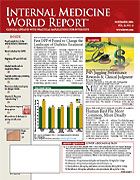Publication
Article
Internal Medicine World Report
Osteoporosis: A Silent Epidemic Among Men in VA Centers
Osteoporosis: A Silent Epidemic Among Men in VA Centers
By John Schieszer
SEATTLE—Nearly 12.5% of all men in the VA Health Care System (almost half a million men) have osteoporosis but are not aware of this, and the percentage may be similar in men in the general community, according to data presented at the American Society for Bone and Mineral Research annual meeting.
“I hope this is a wake up call,” said lead investigator Robert Adler, MD, of the Virginia Commonwealth University School of Medicine and chief of endocrinology and metabolism, McGuire VA Medical Center, both in Richmond, Va. “There are lots of men in the community who aren’t getting diagnosed for osteoporosis either…. We need to identify those at highest risk for fracture.”
Data from screening studies in 2 VA medical centers in New York and Virginia were used to estimate the frequency of osteoporosis in men receiving medical care. The Osteoporosis Self-Assessment Tool (OST), a simple screening tool based only on weight and age, was used to determine which men seen in primary care settings were at risk for the condition.
Those referred by their primary care physicians had dual-energy x-ray absorptiometry (DXA). Data from the DXA and OST modalities were used to assess the total number of men with undiagnosed osteoporosis. At the New York site, spine and hip DXA of 612 men showed that 138 of them (22.5%) had osteoporosis and 265 (43.3%) had osteopenia. At the Virginia site, DXA data of 441 men showed that 109 (24.7%) had osteoporosis and 239 (54.1%) had osteopenia. The OST results showed that 23.5% of the men had silent osteoporosis.
“It isn’t just a woman’s disease. Men actually do worse after a hip fracture. A larger percentage of men die or lose their independence if they survive. So preventing hip fractures should prevent a lot of morbidity and mortality,” said Dr Adler. He reminded primary care physicians to become more aware of “the silent epidemic of osteoporosis” among their male patients aged ³50 years.
In primary care clinics in Virginia, 5645 of 15,027 men (37.6%) were found to be at moderate or high risk for osteoporosis, according to OST scores. Currently, 4.5 million veterans are receiving care from the VA Department; it is estimated that 3.8 million of them are men. Based on these numbers, the researchers calculated that about 335,768 veteran men have silent osteoporosis.
And when adding forearm DXA to spine and hip measurements, it is estimated that 475,790 veteran men have osteoporosis; this adds up to 12.5% of veteran men being unaware of their osteoporosis.
Screening methods such as the OST should be more widely used by primary care physicians to uncover osteoporosis in men. Bone density testing is expensive, but “by using a tool like this [OST] to stratify men, you can find men at higher risk for osteoporosis, and this will be much more cost-effective,” said Dr Adler.
About 20% of all osteoporosis-related fractures occurring annually in the United States are in men. Osteoporosis in men is similar to cardiovascular disease in women; until recently, heart disease was considered to be “a man’s disease,” and many women aged ³50 years were not properly managed. This is now the case for men at risk for osteoporosis.
“We are missing the boat on early intervention,” said Cory Baillie, MD, a rheumatologist in private practice in Winnipeg, Canada. “In the past several years there has been an increased interest in osteoporosis in the male population at the research level but it hasn’t necessarily filtered down to clinical practice as yet.”
